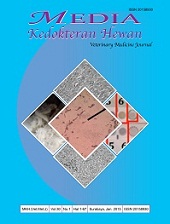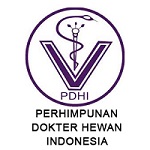Effect of Fermented Feeds on Weaned Piglets Experimentally Infected with Escherichia coli
Downloads
Sixty large white breed piglets aged between 28 and 35 days were randomly assigned to five replicate groups (Bu1, Bu2, Bd1, Bd2, Bs1, Bs2, Lc1, Lc2, C1, and C2) with six pigs per group. The Bu1 and Bu2 groups were fed with wet and dry basal diets, respectively, supplemented with 0.8 mL (6 x 106 colony-forming units (CFU)) of Lactobacillus isolated from burukutu (beverage made from sorghum grains). The Pg1 and Pg2 groups were fed with wet and dry basal diets, respectively, supplemented with 0.8 mL (6 x 106 CFU/mL) of Lactobacillus isolated from pig hindguts. The Bs1 and Bs2 groups were fed with wet and dry basal diets supplemented with 0.8 mL (6 x 106 CFU/mL) of Bacillus subtilis and Bacillus pumilus, respectively. The Lc1 and Lc2 groups were fed with wet and dry basal diets supplemented with 0.8 mL (6 x 106 CFU/mL) of Lactobacillus acidophilus, respectively. Meanwhile, the C1 and C2 groups as the control groups were fed with wet and dry basal diets, respectively. The treatment and control animals were infected with Escherichia coli at 6 mL (1 x 1010 CFU/mL) orally. Aseptically collected fecal samples from the piglets in each group showed significant bacteriological and pathological differences. This study suggested that Lactobacillus species isolated from burukutu, pig hindguts, and industrial probiotics could inhibit colibacillosis.
Abudabos, A.M., A.H. Alyemni and M.B. Marshad. 2013. Bacillus subtilis PB6 based-probiotic (CloSTATTM) improves intestinal morpholgical and microbiological status of broiler chickens under Clostridium perfringens challenge. Int. J. Agric. Biol; 15: 978–982.
Adenipekun, E.O., C.R. Jackson, A. Oluwadun, B.A. Iwalokun, J.G. Frye, J.B. Barrett, L.M. Hiott and T.A. Woodley. 2015. Prevalence and Antimicrobial Resistance in Escherichia coli from Food Animals in Lagos, Nigeria. Microb. Drug. Resist; 21(3): 358–365. doi: 10.1089/mdr.2014.0222.
Ahmed, S.T., J.A. Hwang, J. Hoon, H.S. Mun and C.J. Yang. 2014. Comparison of single and blend acidifiers as alternative to antibiotics on growth performance, fecal microflora, and humoral immunity in weaned piglets. Asian Australas J. Anim. Sci; 27: 93–100.
Aliyu, Y.A., I.J. Musa and T.T. Youngu. 2013. Appraisal of Sulphur contamination from Transportation in Urban Zaria, Nigeria. Int. Lett. of Nat. Sci; 2(10): 155–163.
Amezcua. R., R.M. Friendship, C.E. Dewey, C. Gyles and J.M. Fairbrother. 2002. Presentation of postweaning Escherichia coli diarrhea in southern Ontario, prevalence of hemolytic E. coli serogroups involved, and their antimicrobial resistance patterns. Can. J. Vet. Res; 66: 73–78.
Blecha, F., D.S. Pollmann and D.A. Nichols. 1983. Weaning pigs at an early age decreases cellular immunity. J. Anim. Sci; 56: 396–400.
Cheng, Y.H., L.W. Su, Y.B. Horng and Y.H. Yu. 2019. Effects of soybean meal fermented by Lactobacillus species and Clostridium butyricum on growth performance, diarrhea incidence and fecal bacteria in weaning piglets. Ann. Anim. Sci; 19: 1051–1062. doi: 10.2478/aoas-2019-0042.
Crouch, C.F. and G.N. Woode. 1978. Serial studies of virus multiplication and intestinal damage in gnotobiotic piglets infected with rotavirus. J. Med. Microbiol; 11: 325–334.
Dell'Anno, M., M.L. Callegari, S. Reggi, V. Caprarulo, C. Giromini, A. Spalletta, S. Coranelli, C.A. Sgoifo Rossi and L. Rossi. 2021. Lactobacillus plantarum and Lactobacillus reuteri as Functional Feed Additives to Prevent Diarrhoea in Weaned Piglets. Anim. (Basel); 11(6): 1766. doi:10.3390/ani11061766.
Fairbrother, J.M., E. Nadeau and C.L. Gyles. 2005. Escherichia coli in postweaning diarrhea in pigs: An update on bacterial types, pathogenesis, and prevention strategies. Anim. Health Res. Rev; 6:17–39.
Foo, H.L., Y.Z. Lim and G. Rusul. 2001. Isolation of bacteriocin producing lactic acid bacteria from Malaysia fermented food, Tapai. In: Proceeding of 11th World Congress of Food Science and Technology, Seoul, Korea.
Gardiner, G.E., C. Heinemann, M.L. Baroja, A.W. Bruce, D. Beuerman, J. Madrenas and G. Reid. 2002. Oral administration of the probiotic combination Lactobacillus rahmnosus GR-1 and L. fermentum RC-14 for human intestinal applications. Int. Dairy J; 12(2-3): 191–196.
Gracia, M.I., S. Hansen, J. Sanchez and P. Medel. 2004. Efficacy of addition of B. licheniformis and B. subtilis in pig diets from weaning to slaughter. J. Anim. Sci; 82: 26–26.
Hojberg, O., N. Canibe, B. Knodsen and B.B. Jensen. 2003. Potential rates of fermentations in digesta from the gastrointestinal tract of pigs. Effect of feeding fermented liquid feed. Appl. Environ. Microbiol; 69(1): 408–418.
Horng, Y.B., Y.H. Yu, A. Dybus, F.S. Hsiao and Y.H. Cheng. 2019. Antibacterial activity of Bacillus species-derived surfactin on Brachyspira hyodysenteriae and Clostridium perfringens. AMB Expr; 9: 188. doi: 10.1186/s13568-019-0914-2.
Hu, Y., Y. Dun, S. Li, S. Zhao, N. Peng and Y. Liang. 2014. Effects of Bacillus subtilis KN-42 on growth performance, diarrhea and faecal bacterial flora of weaned piglets. Asian-Australas J. Anim. Sci; 27: 1131–1140. doi: 10.5713/ajas.2013.13737.
Igbokwe, I.O. and C.V. Maduka. 2018. Disease burden affecting pig production in Nigeria. Review of current issues and challenges. Revue d'élevage et de Médecine Vétérinaire des Pays Tropicaux; 71(1-2): 87–95.
Ishii, S. and M.J. Sadowsky. 2008. Escherichia coli in the Environment: Implications for Water Quality and Human Health. Microbes Environ; 23(2): 101–108.
Jensen, H., S. Roos, H. Jonsson, I. Rud, S. Grimmer, J.P. van Pijkeren, R.A. Britton and L. Axelsson.2014. Role of Lactobacillus reuteri cell and mucus-binding protein A (CmbA) in adhesion to intestinal epithelial cells and mucus in vitro. Microbiol; 160(4): 671–681. 10.1099/mic.0.073551-0
Kanitz, E., M. Tuchscherer, A. Tuchscherer, B. Stabenow and G. Manteuffel. 2008. Neuroendocrine and immune responses to acute endotoxemia in suckling and weaned piglets. Biol. Neonate; 81: 203–209.
Karaye, G.P., A.C. Kudi, A.K.B. Sackey and M.A. Raji. 2020. Isolation and In Vitro Screening of Lactic Acid Bacteria from Some Local Brewed Drinks, Rotten Fruits, Pig Hindgut and their Characterization. J. Microbiol. Biotechnol; 5(1): 000154. doi: 10.23880/oajmb-16000154
Khan R. and S. Naz. 2013. The applications of probiotics in poultry production. World's Poult. Sci. J; 69: 621–632.
Kick, A.R., M.B. Tompkins, W.L. Flowers, C.S. Whisnant and C.W. Almond. 2012. Effects of stress associated with weaning on the adaptive immune system in pigs. J. Anim. Sci; 90: 649–656.
Kritas, S.K. and R.B. Morrison. 2005. Evaluation of probiotics as a substitute for antibiotics in a large pig nursery. Vet. Rec; 156(14): 447–448. doi: 10.1136/vr.156.14.447.
Lo Verso, L., M. Lessard, G. Talbot, B. Fernandez and I. Fliss. 2018. Isolation and Selection of Potential Probiotic Bacteria from the Pig Gastrointestinal Tract. Probiotics Antimicrob Proteins. 10(2): 299–312. doi: 10.1007/s12602-017-9309-3.
Marquardt, R.R., L.Z. Jin, J.W. Kim, L. Fang, A.A. Frohlich and S.K. Baidoo. 1999. Passive protective effect of egg-yolk antibodies against enterotoxigenic Escherichia coli K88+ infection in neonatal and early weaned piglets. FEMS Immunol. Med. Microbiol; 23(4): 283–288.
Missotten, J.A.M., J. Michiels, J. Degroote and S. De Smet. 2015. Fermented liquid feed for pigs: an ancient technique for the future. J. Anim. Sci. Biotechnol; 6(1): 1–9.
Mourand, G., P. Frédéric, G. Pauline, P. Lucas, S. Bougeard, E. Denamur and I. Kempf. 2021. Impact of Escherichia coli probiotic strains ED1a and Nissle 1917 on the excretion and gut carriage of extended-spectrum beta-lactamase-producing E. coli in pigs. Vet. Anim. Sci; 14: 100217.
Mulaw, G., T.S. Tessema, D. Muleta and A. Tesfaye. 2019. In Vitro Evaluation of Probiotic Properties of Lactic Acid Bacteria Isolated from Some Traditionally Fermented Ethiopian Food Products. Int. J. Microbiol; 25: 7179514. doi: 10.1155/2019/7179514.
Owusu-Asiedu, A., C.M. Nyachoti and R.R. Marquardt. 2003. Response of early weaned pigs to an Enterotoxigenic Escherichia coli (K88) challenge when fed diets containing spray-dried porcine plasma or pea protein isolate plus egg yolk antibody, Zinc oxide, Fumaric acid or antibiotic. J. Anim. Sci; 81(7): 1790–1798.
Park, C., J. Jeong, K. Choi, J. Chul, J. Lee, O. Kwon, S. Kim and C. Chae. 2015. Inhibition of In Vitro Growth of Porcine Enterotoxigenic and Shiga Toxin-Producing Escherichia Coli by Lactobacillus Plantarum Strains. Short Commun; 65(3): 429–435.
Rhouma, M., J.M. Fairbrother, F. Beaudry and A. Letellier. 2017. Postweaning diarrhea in pigs: risk factors and non-colistin-based control strategies. Acta Vet. Scan; 59: 31. https://doi.org/10.1186/s13028-017-0299-7
Russell, J.B. and F. Diez-Gonzalez. 1998. The effects of fermentation acids on bacterial growth. Adv. Microb. Physiol; 39: 205–234.
Thaniyavarn, J., N. Roongsawang, T. Kameyama, M. Haruki, T. Imanaka, M. Morikawa and S. Kanaya. 2003. Production and characterization of biosurfactants from Bacillus licheniformis F2.2. Biosci. Biotechnol. Biochem; 67: 1239–1244. doi: 10.1271/bbb.67.1239.
Tsai, C.C., P.P. Lin and Y.M. Hsieh. 2008. Three Lactobacillus strains from healthy infant stool inhibit enterotoxigenic Escherichia coli grown in vitro. Anaerobe; 14(2): 61–67.
Tuohy, K.M., M. Pinart-Gilberga, M. Jones, L. Hoyles, A.L. McCartney and G.R. Gibson. 2007. Survivability of a probiotic Lactobacillus casei in the gastrointestinal tract of healthy human volunteers and its impact on the faecal microflora. J. Appl. Microbiol; 102(4): 1026–1032.
Valentim, J.K., J.P. Mendes, F.R. Caldara, R.T.R. Pietramale and R.G. Gracia. 2021. Meta- analysis of relationship between weaning age and daily weight gain of piglets in the farrowing nursery phases. S. Afr. J. Anim. Sci; 51(3): 332–338.
Van Winsen, R.L., B.A.P. Urlings, L.J.A. Lipman, J.M.A. Snijders, D. Keuzenkamp, J.H.M. Verheijden and F. Van Knapen. 2001. Effect of fermented feed on the microbial population of the gastrointestinal tracts of pigs. Appl. Environ. Microbiol; 67(7): 3071–3076.
Copyright (c) 2024 Gloria Pisha Karaye, Shola David Ola-Fadunsin, Polycarp Nwunuji Tanko, Caleb Ayuba Kudi

This work is licensed under a Creative Commons Attribution-ShareAlike 4.0 International License.

Veterinary Medicine Journal by Unair is licensed under a Creative Commons Attribution-ShareAlike 4.0 International License.
1. The Journal allows the author to hold the copyright of the article without restrictions.
2. The Journal allows the author(s) to retain publishing rights without restrictions
3. The legal formal aspect of journal publication accessibility refers to Creative Commons Attribution Share-Alike (CC BY-SA).





11.jpg)







11.png)













